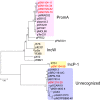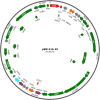Novel Self-Transmissible and Broad-Host-Range Plasmids Exogenously Captured From Anaerobic Granules or Cow Manure
- PMID: 30459733
- PMCID: PMC6232296
- DOI: 10.3389/fmicb.2018.02602
Novel Self-Transmissible and Broad-Host-Range Plasmids Exogenously Captured From Anaerobic Granules or Cow Manure
Abstract
Novel self-transmissible plasmids were exogenously captured from environmental samples by triparental matings with pBBR1MCS-2 as a mobilizable plasmid and Pseudomonas resinovorans as a recipient. A total of 272 recipients were successfully obtained as plasmid host candidates from granules of an anaerobic methane fermentation plant and from cow manure. The whole nucleotide sequences of six plasmids were determined, including one IncP-1 plasmid (pSN1104-59), four PromA-like plasmids (pSN1104-11, pSN1104-34, pSN0729-62, and pSN0729-70), and one novel plasmid (pSN1216-29), whose incompatibility group has not been previously identified. No previously known antibiotic resistance genes were found in these plasmids. In-depth phylogenetic analyses showed that the PromA-like plasmids belong to subgroups of PromA (designated as PromAγ and PromAδ) different from previously proposed subgroups PromAα and PromAβ. Twenty-four genes were identified as backbone genes by comparisons with other PromA plasmids. The nucleotide sequences of pSN1216-29 share high identity with those found in clinical isolates. A minireplicon of pSN1216-29 was successfully constructed from repA encoding a replication initiation protein and oriV. All the captured plasmids were found to have a broad host range and could be transferred to and replicated in different classes of Proteobacteria. Notably, repA and oriV of pSN1216-29 showed high similarity with one of two replication systems of pSRC119-A/C, known as a plasmid with multidrug resistance genes found in Salmonella enterica serovar Senftenberg. Our findings suggest that these "cryptic" but broad-host-range plasmids may be important for spreading several genes as "vehicles" in a wider range of bacteria in natural environments.
Keywords: PromA; broad host range; conjugation; plasmid; replication.
Figures





Similar articles
-
Hitherto-Unnoticed Self-Transmissible Plasmids Widely Distributed among Different Environments in Japan.Appl Environ Microbiol. 2022 Sep 22;88(18):e0111422. doi: 10.1128/aem.01114-22. Epub 2022 Sep 7. Appl Environ Microbiol. 2022. PMID: 36069618 Free PMC article.
-
Determination of Plasmid pSN1216-29 Host Range and the Similarity in Oligonucleotide Composition Between Plasmid and Host Chromosomes.Front Microbiol. 2020 Jun 9;11:1187. doi: 10.3389/fmicb.2020.01187. eCollection 2020. Front Microbiol. 2020. PMID: 32582111 Free PMC article.
-
The broad-host-range plasmid pSFA231 isolated from petroleum-contaminated sediment represents a new member of the PromA plasmid family.Front Microbiol. 2015 Jan 12;5:777. doi: 10.3389/fmicb.2014.00777. eCollection 2014. Front Microbiol. 2015. PMID: 25628616 Free PMC article.
-
The behavior and significance of degradative plasmids belonging to Inc groups in Pseudomonas within natural environments and microcosms.Microbes Environ. 2010;25(4):253-65. doi: 10.1264/jsme2.me10155. Microbes Environ. 2010. PMID: 21576880 Review.
-
The behavior of mobile genetic elements (MGEs) in different environments.Biosci Biotechnol Biochem. 2017 May;81(5):854-862. doi: 10.1080/09168451.2016.1270743. Epub 2017 Jan 12. Biosci Biotechnol Biochem. 2017. PMID: 28077029 Review.
Cited by
-
Non-antibiotic pharmaceuticals promote conjugative plasmid transfer at a community-wide level.Microbiome. 2022 Aug 12;10(1):124. doi: 10.1186/s40168-022-01314-y. Microbiome. 2022. PMID: 35953866 Free PMC article.
-
Comparative Genomics Suggests Mechanisms of Genetic Adaptation toward the Catabolism of the Phenylurea Herbicide Linuron in Variovorax.Genome Biol Evol. 2020 Jun 1;12(6):827-841. doi: 10.1093/gbe/evaa085. Genome Biol Evol. 2020. PMID: 32359160 Free PMC article.
-
Transconjugant range of PromA plasmids in microbial communities is predicted by sequence similarity with the bacterial host chromosome.Microb Genom. 2023 Jun;9(6):mgen001043. doi: 10.1099/mgen.0.001043. Microb Genom. 2023. PMID: 37341708 Free PMC article.
-
On-Farm Anaerobic Digestion of Dairy Manure Reduces the Abundance of Antibiotic Resistance-Associated Gene Targets and the Potential for Plasmid Transfer.Appl Environ Microbiol. 2021 Jun 25;87(14):e0298020. doi: 10.1128/AEM.02980-20. Epub 2021 Jun 25. Appl Environ Microbiol. 2021. PMID: 33931422 Free PMC article.
-
Hitherto-Unnoticed Self-Transmissible Plasmids Widely Distributed among Different Environments in Japan.Appl Environ Microbiol. 2022 Sep 22;88(18):e0111422. doi: 10.1128/aem.01114-22. Epub 2022 Sep 7. Appl Environ Microbiol. 2022. PMID: 36069618 Free PMC article.
References
-
- Arakawa K., Suzuki H., Tomita M. (2008). Computational genome analysis using the G-language system. Genes Genomes Genomics 2 1–13. - PubMed
LinkOut - more resources
Full Text Sources
Molecular Biology Databases
Research Materials

